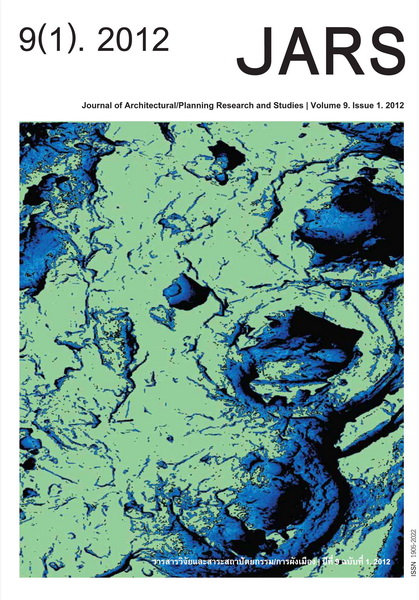Field Efficiency of Split-Type Air Conditioners with Evaporative-Cooled Condensers
Main Article Content
Abstract
In Thailand, split–type air conditioners are commonly used in residential buildings. These mainly rely on air-cooled compressors for the heat rejection process. However, the constant hot-humid conditions of Thailand reduce the efficiency of air conditioning systems significantly. As a result, an indirect evaporative condenser was proposed as a solution to improve the performance of a split–type system. Though the laboratory tests are promising, this system still requires field testing as dynamic ‘real’ conditions could be significantly different to a laboratory controlled scenario.
This research aims to study the field performance of split–type air conditioners with air cooled and evaporative condensers during day time, night time and throughout a 24-hour cycle. The results from this research were the comparison of the Coefficient of Performance (COP), electricity consumption and energy expense. Based on these results, the most effective user pattern for when an evaporative condenser is applied can be determined. This can provide efficient gudelines to save energy when using evaporative condensers in residential buildings.
The research results indicate that the field performance efficiency of an evaporative condenser is lower than that of the laboratory test. The impact from the cooling load is the main cause. By operating with a sufficient cooling load, the performance of an evaporative system could be enhanced. This could happen through heat transfer in summer or heat accumulation during the early hours of turning on the air conditioner. Moreover, low outdoor relative humidity is an additional factor to boost the performance of this system. Based on these findings, an air conditioner with evaporative condensers reduces energy consumption by 14.98 percent during daytime, 9.49 percent during nighttime and 4.26 percent through a 24-hour cycle. Given these results, the evaporative condenser should be used in rooms with daytime usage, which are the best candidate for an evaporative system. The second best option would be rooms with nighttime usage such as the bedroom because of the significant accumulation of heat from the day. 24-hour usage is the least suitable application for this system because energy savings could not be expected during the night.
Downloads
Article Details

This work is licensed under a Creative Commons Attribution-NonCommercial-NoDerivatives 4.0 International License.
All material is licensed under the terms of the Creative Commons Attribution 4.0 International (CC-BY-NC-ND 4.0) License, unless otherwise stated. As such, authors are free to share, copy, and redistribute the material in any medium or format. The authors must give appropriate credit, provide a link to the license, and indicate if changes were made. The authors may do so in any reasonable manner, but not in any way that suggests the licensor endorses you or your use. The authors may not use the material for commercial purposes. If the authors remix, transform, or build upon the material, they may not distribute the modified material, unless permission is obtained from JARS. Final, accepted versions of the paper may be posted on third party repositories, provided appropriate acknowledgement to the original source is clearly noted.
References
Chalermpipat, T. (2009). การปรับอากาศ [Air-conditioning]. Retrieved August 15, 2009, from http://www.reocities.com/auto_aircond/basic.html.
Department of Alternative Energy Development and Efficiency. (2009). การใช้พลังงานไฟฟ้า [Electric energy utilization]. In Electric power in Thailand. Bangkok, Thailand: Ministry of Energy.
Electricity Generating Authority of Thailand. (2005). เครื่องปรับอากาศเบอร์ 5 [Air conditioner No. 5]. Retrieved December 27, 2008, from http://www2.egat.co.th/labelNo5/air_Saving.htm.
Goswami, D. Y., Mathur, G. D., & Kulkarni, S. M. (1993). Experimental investigation of performance of a residential air conditioning system with an evaporatively cooled condenser. Journal of Solar Energy Engineering, 115(4), 206-211.
Hajidavaloo, E. (2007). Application of evaporative cooling on the condenser of window-air-conditioner. Applied Thermal Engineering, 27(11-12), 1937-1943.
Hwang, Y., Radermacher, R., & Koppo, W. (2000). An experimental evaluation of a residential-sized evaporatively cooled condenser. International Journal of Refriganation 24(3), 238-249.
Rojanapaibulya, W. (2009). นวัตกรรมเครื่องปรับอากาศแยกส่วน [Split-type air conditioning innovation]. Bangkok, Thailand: Architectural Design by Energy Research, King Mongkut’s Institute of Technology Ladkrabang.
Sumotayakul, S. (1990). เครื่องทำความเย็นและเครื่องปรับอากาศ [Refrigeration and air conditioning system]. Bangkok, Thailand: Se-education.
Turki, A. M., & Zaki, G. M. (1991). Energy saving through intermittent evaporative roof Cooling. Energy and Building, 17(1), 35-42.


